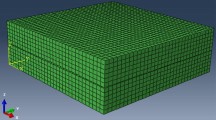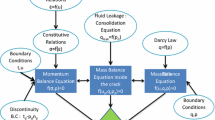Abstract
Anisotropic stress states are common in the upper crust and result in fracture apertures being dependent on fracture orientation. Fractured rocks should therefore display an anisotropic permeability determined by the aperture, length, and orientation of those fractures remaining open. In this paper, a numerical study of this effect is made for a rock containing two orthogonal fracture sets subject to a uniaxial compressive stress applied perpendicular to one of the sets. With increasing compressive stress, the decreasing aperture of fractures orientated perpendicular to the stress axis leads to a decrease in permeability both parallel and perpendicular to the stress. For flow parallel to the stress direction, this is a consequence of the finite length of the fractures, flow in fractures perpendicular to the stress being required to connect fractures orientated parallel to the stress direction. As the number of fractures is decreased towards the percolation threshold, the average permeability tensor is found to become increasingly isotropic. This behaviour results from the highly tortuous nature of the flow paths just at the percolation threshold.
Similar content being viewed by others
References
Balberg, I. and Binenbaum, N., 1983, Computer study of the percolation threshold in a two-dimensional anisotropic system of conducting sticks, Phys. Rev. B 28, 3799–3812.
Bernasconi, J., 1974, Conduction in anisotropic disordered systems: Effective medium theory, Phys. Rev. B 9, 4575–4579.
Brace, W. F., 1978, A note on permeability changes in geological material due to stress, Pageoph 116, 627–633.
Brower, K. R. and Morrow, N. R., 1985, Fluid flow in cracks as related to low-permeability gas sands, Soc. Petroleum Eng. J. 25, 191–201.
Charlaix, E., 1986, Percolation threshold of a random array of discs: a numerical simulation, J. Phys. A 19, L351-L354.
Dienes, J. K., 1982, Permeability, percolation and statistical crack mechanics, in R. E. Goodman and F. E. Heuze (eds), Issues in Rock Mechanics American Inst. Mining, Metallurgical and Petroleum Eng., New York, pp. 86–94.
Englman, R., Gur, Y. and Jaeger, Z., 1983, Fluid flow through a crack network in rocks, J. Appl. Mech. 50, 707–711.
Gale, J. E., 1975, A numerical field and laboratory study of flow in rocks with deformable fractures, PhD Thesis, Univ. California, Berkeley.
Gueguen, Y., David, C. and Darot, M., 1986, Models and time constants for permeability evolution, Geophys. Res. Letts. 13, 460–463.
Gueguen, Y., Darot, M. and Reuschle, T. 1987, Permeability evolution under stress, in Migration of Hydrocarbons in Sedimentary Basins, Editions Technip, Paris, pp. 281–295.
Kirkpatrick, S., 1973, Percolation and conduction, Rev. Mod. Phys. 45, 574–588.
Lamb, H., 1932, Hydrodynamics, 6th edn., Cambridge University Press.
Lobb, C. J., Frank, D. J., and Tinkham, M., 1981, Percolative conduction in anisotropic media: A renormalisation group approach, Phys. Rev. B 23, 2262–2268.
Oda, M., 1985, Permeability tensor for discontinuous rock masses, Geotechnique 35, 483–495.
Robinson, P. C., 1984, Connectivity, flow and transport in network models of fractured media, AERE Report TP.1072.
Shklovskii, B. I., 1978, Anisotropy of percolation conduction, Phys. Stat. Sol. B 85, K111-K114.
Snow, D. T., 1969, Anisotropic permeability of fractured media, Water Resour. Res. 5, 1273–1289.
Somerton, W. H., Soylemezoglu, I. M. and Dudley, R. C., 1975, Effect of stress on permeability of coal, Int. J. Rock. Mech. Geomech. Abstr. 12, 129–145.
Walsh, J. B., 1965, The effects of cracks on the compressibility of rocks, J. Geophys. Res. 70, 381–389.
Witherspoon, P. A. and Gale, J. E., 1977, Mechanical and hydraulic properties of rocks related to induced seismicity, Eng. Geol. 11, 23–55.
Author information
Authors and Affiliations
Rights and permissions
About this article
Cite this article
Sayers, C.M. Stress-induced fluid flow anisotropy in fractured rock. Transp Porous Med 5, 287–297 (1990). https://doi.org/10.1007/BF00140017
Received:
Issue Date:
DOI: https://doi.org/10.1007/BF00140017




